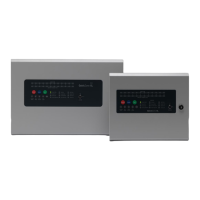
Do you have a question about the Advanced Quick Zone XL and is the answer not in the manual?
| Brand | Advanced |
|---|---|
| Model | Quick Zone XL |
| Category | Control Panel |
| Language | English |
Provides a general overview of the QuickZone XL panel's features and capabilities.
Details the physical dimensions and layout of the QuickZone XL panel cabinet.
Describes the main and ancillary circuit boards used in the QuickZone XL panels.
Details the terminal connections on the main PCB for system wiring.
Details the terminal connections for zone extension cards.
Describes the specifications and functions of the power supply module.
Electrical specifications for the main PCB inputs and outputs.
Electrical specifications for the communications PCB inputs and outputs.
General physical and compatibility specifications for the panel.
Guidance on system design, zone planning, detector placement, and sounder/beacon requirements.
Recommends specific cable types and limits for system wiring to ensure EMC compliance.
Guidelines for routing cables into the cabinet and proper earthing termination.
Specifies maximum recommended cable lengths for circuits, noting dependency on device count.
Details requirements for a safe and compliant hard-wired mains supply connection.
Diagrams illustrating typical wiring for conventional detection and sounder circuits.
Diagrams illustrating typical wiring for twin wire detection and sounder circuits.
Emphasizes safety precautions for installation, compliance, and handling.
Details precautions to prevent Electrostatic Discharge damage to components.
General installation advice, including cable segregation and power for ancillary devices.
Instructions on selecting a site and securely mounting the panel cabinet.
Guidance on safely connecting the incoming mains supply to the panel.
Instructions for correctly connecting the system batteries.
Procedures for checking battery charging voltage and adjustments.
Explains Twin Wire technology and how to configure it using DIL switches.
Configures the last zone for interconnection with other control panels.
Accessing and using advanced engineering options via keypad codes and DIL switches.
An index of available programmable options and their corresponding codes and pages.
How to change, remove, or disable the keypad access code for panel control.
Configures the quantity of repeater panels connected to the system for monitoring.
Sets the delay duration for all outputs, configurable from 1 to 10 minutes.
Option to disable battery monitoring for specific applications or non-backup scenarios.
Programs the panel for added internal PCBs like zone cards or repeater comms PCBs.
Sets the type of monitoring for repeater communications, fault tolerant or radial.
Allows automatic clearing of fire signals when the input is removed.
Enables short circuits to trigger a fire alarm, not just a fault condition.
Adjusts thresholds for using intrinsically safe barriers in zone circuits.
Provides visual/audible alarms without sounder operation.
Allows disabling the priority alarm feature, which normally overrides delays.
Option to turn off detector removal monitoring for older detectors.
Selects between Schottky or Zener diode detector bases for conventional zones.
Defines a sequence where the first detector alarm is inhibited and re-checked.
Defines a sequence where the first detector alarm is indicated but not activated, with re-check.
Defines a sequence where a full fire condition requires a second detector or call point activation.
Allows selection of the overall dependency mode (A, B, or C) for the panel.
Specifies which zones should be included in the active dependency mode.
Configures confirmation and auto-reset timings for Dependency Mode B.
Configures compatibility for Twin Wire mode with specific detector types.
Controls whether new alarms cause sounders to resound after silencing.
Configures delays for sounder circuits and auxiliary outputs for selected zones.
Programs functions for Class Change and Alert inputs.
Enables programming of outputs and sets miscellaneous functions like fault latching.
Sets specific responses (ON, OFF, PULSING) for relays and outputs per zone.
Sets responses for conventional sounder circuits for each zone.
Sets responses for Twin Wire sounder circuits for each zone.
Sets responses for Comms PCB outputs for selected zones.
Programs custom responses for outputs to Silence Alarms, Evacuate, etc.
Programs functional options for Twin Wire sounder circuits.
Programs functional options for conventional sounder circuits.
Programs custom responses for Comms PCB outputs to panel functions.
Helps diagnose system faults by checking PCB and repeater configuration.
Guides through fitting Comms PCBs and setting up repeater panels.
Explains how to set unique addresses for repeater panels using DIL switches.
Details programming the functions of repeater panels from the main control panel.
Describes the front panel controls, LEDs, and their functions.
Explains the meaning of each status LED indicator on the panel.
Details the functions of the keypad buttons for operation and programming.
How to disable individual zone circuits or outputs.
Procedures for testing the fire alarm system, with or without sounders.
How to diagnose faults using LED indications and the ENTER button.
Explains panel behavior and indications during system faults.
Step-by-step guide for users during an alarm condition.
Explains the importance of regular inspection and servicing for system reliability.
Outlines the responsibilities of the appointed person for system maintenance.
Details daily and weekly maintenance and testing procedures.
Recommendations for periodic service visits and battery replacement.
A logbook section for recording weekly tests.
A logbook for recording false alarms, faults, and engineer visits.